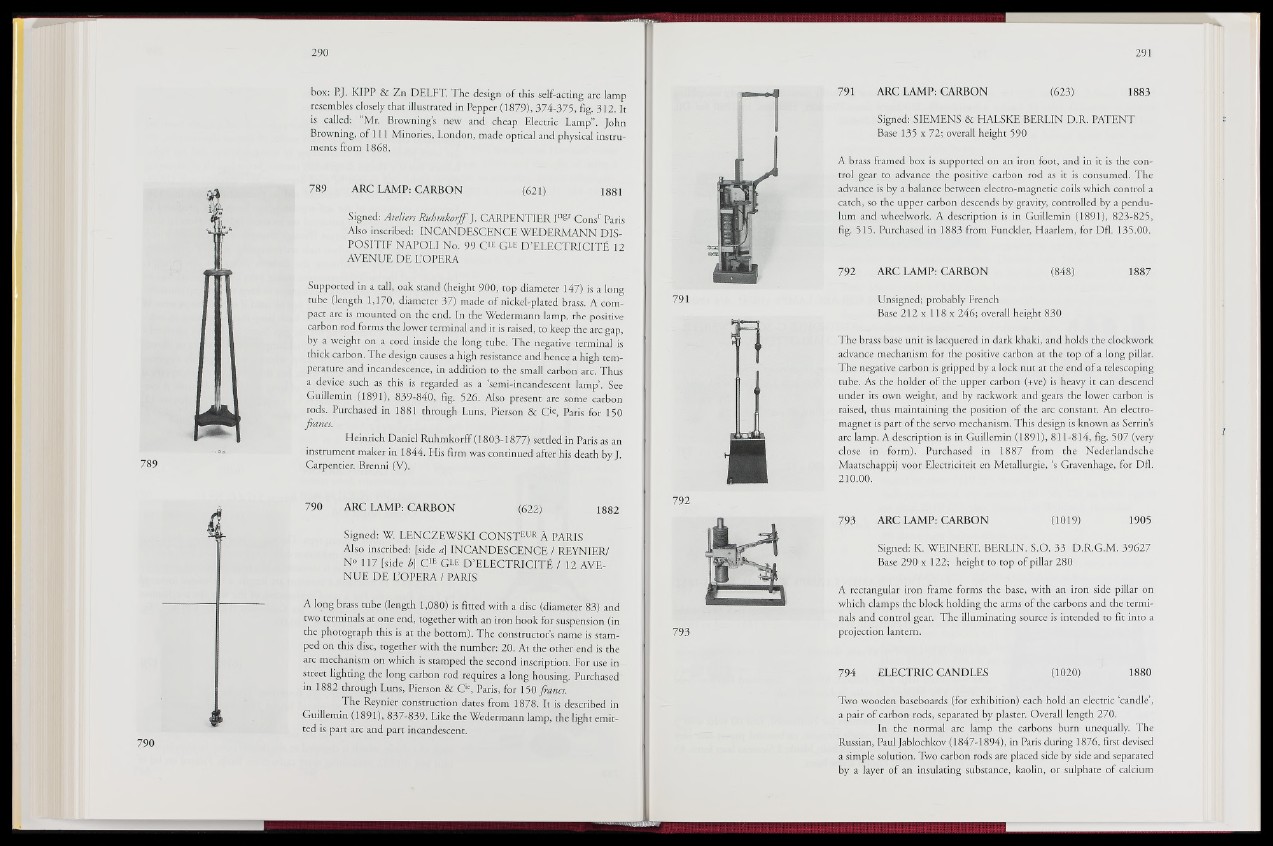
box: P.J. KIPP & Zn DELFT. The design of this self-acting arc lamp
resembles closely that illustrated in Pepper (1879), 374-375, fig. 312. It
is called: “Mr. Brownings new and cheap Electric Lamp’s fJohn
Browning, of 111 Minories, London, made optical and physical instruments
from 1868.
789 ARC LAMP: CARBON (621) 1881
Signed: Ateliers Ruhmkorff], CARPENTIER In8r Consr Paris
Also inscribed: INCANDESCENCE WEDERMANN DIS-
POSITIF NAPOLI No. 99 Cie Gle D’ELECTRICITfi 12
AVENUE DE L’OPERA
Supported in a tall, oak stand (height 900, top diameter 147) is a long
tube (length 1,17Q, diameter 37) made of nickel-plated brass. A compact
arc is mounted on the end. In the Wedermann lamp, the positive
carbon rod forms the lower terminal and it is raised, to keep the arc gap,
by a weight on a cord inside the long tube. The negative terminal is
thick carbon. The design causes a high resistance and hence a high temperature
and incandescence, in addition to the small carbon arc. Thus
a device such as this is regarded as a ’semi-incandescent lamp’. See
Guillemin (1891),. 839-840, fig. 526. Also present are some carbon
rods. Purchased in 1881 through Luns, Pierson & Cie, Paris for 150
francs.
Heinrich Daniel Ruhmkorff (1803-1877) settled in Paris as an
instrument maker in 1844. His firm was continued after his death by J.
Carpentier. Brenni (V),
790 ARC LAMP: CARBON (622) 1882
Signed: W. LENCZEWSKI CONSTEUE- A PARIS
Also inscribed: [side a] INCANDESCENCE / REYNIER/
N° 117 [side b\ CIE GLE D’ELECTRICITfi ¡§.2 AVE-
N U gD E L’OPERA / PARIS
A long brass tube (length 1,080) is fitted with a disc (diameter 83) and
two terminals at one end, together with an iron hook for suspension (in
the photograph this is at the bottom). The constructor’s name is stamped
on this disc, together with the number: 20. At the other end is the
arc mechanism on which is stamped the second inscription. For use in
street lighting the long carbon rod requires a long housing. Purchased'
in 1882 through Luns, Pierson & Cis, Paris, for 150 francs.
The Reynier construction dates from 1878. It isjdeseribed in
Guillemin (1891),.837-839. Like the Wedermann lamp, the light emitted
is part arc and part incandescentaBI
791 ARC LAMP: CARBON (623.)) 1883
Signed: SIEMENS & HALSKE BERLIN D.R. PATENT
Base 135 x 72; overall height 590
A brass framed box is supported on an iron foot, and in it is the control
gear to advance the positive carbon rod as it is consumed. The
advance is by a balance between electro-magnetic coils which control a
catch, so the upper carbon descends by gravity, controlled by a pendulum
and wheelwork. A description is in Guillemin (1891), 823-825,
fig. 515. Purchased in 1883 from Funckler, Haarlem, for Dfl. 135.00.
792 ARC LAMP: CARBON (848) 1887
Unsigned; probably French
Base 212 x 118 x 246; overall height 830
The brass base unit is lacquered in dark khaki, and holds the clockwork
advance mechanism for the positive carbon at the top of a long pillar.
The negative carbon is gripped by a lock nut at the end of a telescoping
tube. As the holder of the upper carbon (+ve) is heavy it can descend
under its own weight, and by rackwork and gears the lower carbon is
raised, thus maintaining the position of the arc constant. An electromagnet
is part of the servo mechanism. This design is known as Serrin’s
arc lamp. A description is in Guillemin (1891),* 811-814, fig. 507 (very
ISpse in form). Purchased in 1887 from the Nederlandsche
Maatschappij voot Electriciteit en Metallurgie, ‘s Gravenhage, for Dfl.
210.00.
793 ARC LAMP: CARBON (1019) 1905
Signed: K. WEINERT. BERLIN. S.O. 33 D.R.G.M. 39627
Base 290 x 122; height to top of pillar 280
A rectangular iron frame forms the base, with an iron side pillar on
which clamps the block holding the arms of the carbons and the terminals
and control gear. TheHuminating source is intended to fit into a
projection lantern.
794 ELECTRIC CANDLES (1020) ’ 1880
Two wooden baseboards (for exhibition) each hold an electric candle’,
a pair of carbon rods, separated by plaster. Overall length 270.
In the normal arc lamp the carbons burn unequally. The
Russian, Paul Jablochkov (1847-1894), in Paris during 1876, first devised
a simple solution. Two carbon rods are placed side by side and separated
by a layer of an insulating substance, kaolin, or sulphate of calcium